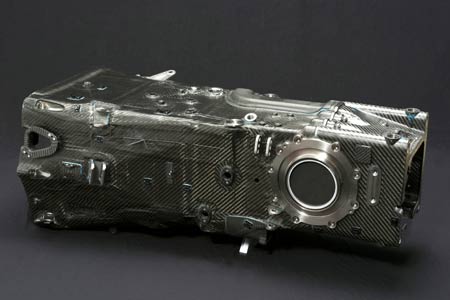Le Mans transmissions
The Le Mans 24 Hours is the sternest test for all racing vehicle systems, especially the transmission. So what are the steps transmission manufacturers take to ensure that these components are durable enough to survive the punishment of a 24-hour race, while still remaining lightweight and as efficient as possible?
One area that has seen considerable development in recent years is the material choice for the transmission casings, with new techniques allowing for lighter units that still have the durability to survive the punishment of Le Mans. This has been especially apparent in the efforts of the leading works teams culminating in Audi's use of a full composite gearbox housing in the 2012 R18 e-tron quattro and ultra LM P1s. This will be covered in more detail later, but first it is worth looking at developments slightly lower down the scale.
Traditionally, motorsport gearboxes have been cast from magnesium or aluminium alloys, and these are still the predominant materials used. Cast magnesium alloy is lightweight and highly fluid when cast; it allows for thin wall sections to be achieved and is more resistant to fatigue than aluminium; however, aluminium is ultimately stronger. For example, RZ5 magnesium, which is used in a number of sportscar gear casings, has a tensile strength of about 200 MPa, compared to BSL169 aluminium alloy, which has a tensile strength of 240 MPa when sand cast.
MSR/EQ21 magnesium is also seeing increased use due to its improved properties at higher operating temperatures, thanks to the incorporation of a higher percentage of rare earths in its chemical composition, while new casting methods that allow for very thin wall sections to be produced has seen aluminium gaining more widespread use. Advances in FEA analysis have allowed for more accurate placement of material, resulting in aluminium casings being marginally lighter than an equivalent magnesium component.
Most of the front-running LMP cars use thinwall aluminium casings, including the Toyota TS030, as did the Peugeot 908 HDi FAPs until 2011 (when the team switched back to a magnesium unit). Thinwall alloy cases are considerably more expensive than magnesium, so the cost-performance benefit is not always clear-cut, especially when the fatigue life of the two materials is taken into account, with aluminium components having a shorter service life than more shock-resistant magnesium parts. There is also a middle ground between aluminium and magnesium in the form of hybrid aluminium-magnesium alloys that provide some of the benefits of both materials.
Over the past two years, Audi has rather upped the ante; the R18 featured an investment cast titanium casing, housed within a carbon 'superstructure' that carried the suspension mounting points. For the R18 e-tron quattro and ultra it went a step further, introducing a fully composite casing, part of an extensive weight-saving programme that looked at all areas of the car.
Fully composite casings first appeared in Formula One in 2002, running in the Arrows A23, with McLaren soon following suite with the MP4-18; however, it has taken most of the decade for the technology to filter down to Le Mans.
The biggest challenge to producing a composite case is in accommodating the complex internal shapes required within a casing, as well as ensuring that the composites remain stable when exposed to potentially high operating temperatures and high loadings on several planes. Advances in FEA analysis software and specific software for ascertaining the optimum lay-up arrangements for composites means that the construction of complex structural parts is now feasible.
Producing a composite transmission is still a daunting prospect, and requires significant resources and expenditure, but as hybrid systems become more prevalent at Le Mans, and teams look to offset the weight they add, it is likely that composite boxes will become more commonplace.

Fig. 1 - The full carbon case from Audi's 2012 R18 e-tron quattro and ultra LM P1s
Written by Lawrence Butcher